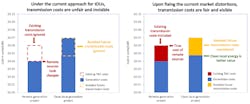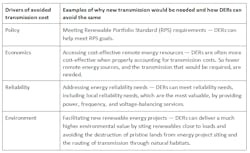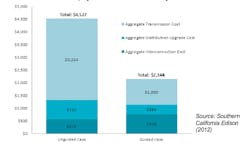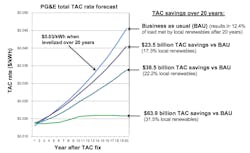How Two Simple Fixes Can Fairly Compensate the True Value of DERs in California
Our electricity transmission system, designed to transport electricity from remote power plants to end-use customers, is effectively a vulnerable supply line that is inherently not resilient. In California, the fragility of the transmission system has been exposed by severe fires, including fires caused by transmission infrastructure, as well as Public Safety Power Shutoffs (PSPS) implemented by investor-owned utilities (IOUs) to avoid additional transmission-ignited wildfires.
California's Transmission Problem
In addition to leaving Californians vulnerable to wildfires and power outages, excessive transmission infrastructure investments are heaping exorbitant and unnecessary costs on California ratepayers. As in the rest of the United States, transmission costs are the fastest-growing portion of California electricity bills — largely accounting for the fact that delivering electricity already costs more than generating it.
As the figure above shows, transmission revenue requirements for IOUs have been trending up sharply, increasing since 2008 at an average annual rate of almost 9.33% for Pacific Gas & Electric (PG&E), 17.99% for Southern California Edison (SCE), and 17.02% for San Diego Gas & Electric (SDG&E). Transmission costs are by far the most rapidly increasing portion of electricity costs for ratepayers.
Important to know is that capital expenditures associated with transmission infrastructure are just the tip of the iceberg, because transmission operations and maintenance (O&M) costs account for almost 10 times more cost impact on ratepayers than the upfront costs of transmission infrastructure — and these extraordinary O&M costs are heaped on ratepayers for 50 years, the typical lifetime of transmission investments.
Transmission Cost Distortions Steal Massive Value From DERs
The way transmission costs are allocated in IOU service territories steal from the value of distributed energy resources (DERs) in the following two ways:
- Costs associated with existing transmission infrastructure are assessed to DERs, even though transmission costs are supposed to be borne only by energy that uses the transmission grid — and DERs do not use it.
- Value associated with avoiding future transmission infrastructure has not been credited to DERs, even though DERs avoid the need for new transmission infrastructure and can save ratepayers hundreds of billions of dollars over the coming decades.
Costs for existing transmission infrastructure
Transmission costs currently average approximately 2 cents/kWh in California, and over the next 20 years, the levelized cost of transmission in current dollars is projected to be 3 cents/kWh. These existing transmission costs steal value from DERs because of the transmission access charges (TAC) market distortion: all energy in California's IOU service territories is charged TAC to use the transmission grid, whether or not that energy ever touches the transmission grid. Locally generated energy stays within the distribution grid, never using the transmission grid — so it should not be assessed this charge. The TAC market distortion artificially inflates the cost of DERs, as TAC should only be added to the cost of remote generation that requires use of the transmission grid to get energy from where it is generated to where it is used on the distribution grid where people live and work.
Value of avoiding future transmission infrastructure
DERs also provide significant value in avoiding the need for new transmission infrastructure, as was shown in the 2017 to 2018 planning process for the California Independent System Operator (CAISO). At that time, the CAISO was able to avoid US$2.6 billion in new transmission spending — in large part because of increased DERs and energy efficiency. Importantly, had this US$2.6 billion in transmission infrastructure been approved, it would have heaped approximately US$25 billion of costs on ratepayers over the 50-year lifetime of the transmission assets, because of the fact that O&M costs increase the initial costs of transmission by an order of magnitude. The portion of future transmission investments that are estimated for accommodating load growth alone is 2.5 cents/kWh, as measured in the evenings, which is the peak usage time of the transmission grid. Given that DERs can provide local dispatchable energy that avoids the need for energy to flow over the transmission grid, this 2.5 cents/kWh should accrue to the price that is paid for appropriately configured DERs.
After considering the TAC market distortion associated with existing transmission infrastructure and the value of DER-avoidable new transmission infrastructure, it is clear that substantial value is being stolen from DERs.
Fixes to Ensure Proper DER Valuation
There are two simple fixes to ensure proper DER valuation:
1. Account for avoided future transmission costs in the Avoided Cost Calculator (ACC)
This fix is already partially in progress. In a big win for DERs in California, the California Public Utilities Commission (CPUC) agreed in April 2020 to include certain avoided future transmission costs as part of DER valuation in the ACC. The CPUC uses the ACC as a key tool to calculate the value of DER projects, programs, policies, and deployments, and to evaluate their cost-effectiveness.
The Clean Coalition, a California nonprofit, had intervened previously at the CPUC to request that the agency conduct a regular review of the ACC. Along with other parties, the Clean Coalition was successful in establishing a review process for the ACC methodology, which is now reviewed and updated every other year to ensure it reflects the many costs avoided by deploying DERs.
Before the April decision, the ACC did include some avoided future transmission costs for the PG&E. However, incomprehensibly, avoided transmission valuation had been entirely omitted in the ACC for the two other major California IOUs: the SCE and the SDG&E. These omissions were continued in the proposed decision that the CPUC issued earlier this year for the current review cycle.
In response to that proposed decision, the Clean Coalition filed comments in early April urging the CPUC to include avoided future transmission costs for all three IOUs in an alternate proposed decision on the ACC. Our comments and the reply comments we filed subsequently, along with input from Vote Solar, the Solar Energy Industries Association (SEIA), and 350 Bay Area, were instrumental in convincing the CPUC to adopt the proper approach in its final decision.
The updates to the ACC will include avoided future transmission costs for all three IOUs, from the limited perspective of load growth only, including improvement of the methodology used for the PG&E. All parties agree that additional refinements are still needed, but this is an important first step in correcting distortions that currently steal from DER valuation.
This fix will ensure that the ACC accounts for the avoided future costs of transmission that would be needed to accommodate forecasted load growth on the transmission grid, measured in megawatts of peak load. However, there are other transmission costs that should also be included in the calculator, such as these:
The proper valuation in the ACC of all future transmission that is avoidable by DERs would likely double the value of avoided future transmission.
2. Reform the way TAC is assessed
While the ACC deals with avoided future transmission costs, it entirely disregards the allocation of costs associated with existing transmission infrastructure. Now is the time to finally eliminate the resulting massive market distortion.
The Clean Coalition has been leading the TAC Campaign to provide a straightforward fix for this historical and unfair market distortion.
Current TAC treatment steals 2 cents/kWh from clean local energy projects in California's IOU service territories — artificially inflating the cost of this energy and needlessly crippling the DER industry, which has the potential to deliver unparalleled economic, environmental, and resilience benefits to every community in the state.
TAC market distortion has huge consequences for ratepayers, because it causes community choice aggregators (CCAs) and IOUs to ignore transmission costs when contracting energy — so they generally buy energy from remote sources that require billions of dollars in transmission infrastructure to reach customers. The more utilities buy from remote energy sources, the more transmission infrastructure has to be built to deliver it, needlessly driving up California’s energy bills. Simply stated, utilities and CCAs buy energy that appears to be cheaper for them but is actually more expensive for ratepayers. This market distortion will continue to worsen until California finally implements the straightforward TAC fix.
By reforming TAC, we can save Californians over US$60 billion in unnecessary transmission spending over the next 20 years. The TAC fix will make clean local energy cheaper, so more DERs will be deployed. That, in turn, will result in less transmission infrastructure being built.
The TAC fix is straightforward: change the way TAC is metered and assessed throughout the CAISO service territory so that all charges are consistently based on actual use of the transmission grid across all utility service territories. Importantly, TAC is already treated properly in the non-IOU service territories. In the IOU service territories, however, TAC is assessed at the customer meter, which means TAC is assessed on all energy, whether traveling over hundreds of miles of transmission or coming from the rooftop next door and never touching the transmission grid. The fix calls for TAC to be assessed at the transmission-distribution substation, which assures that TAC is assessed on only the energy that actually uses the transmission grid.
We know this method works because it is already being implemented correctly for non-participating transmission owner (non-PTO) utilities, such as California's numerous municipal utilities.
There is currently no plan to correct the TAC market distortion but the Clean Coalition and a team of dedicated collaborators are pursuing TAC reform with the California Legislature, the CPUC, and the California Energy Commission (CEC). Although focus in the legislature this year has been diverted by the COVID-19 pandemic, the Clean Coalition designed TAC legislative language that the Legislative Counsel has already approved in early 2020 for legislative inclusion. The TAC Campaign collaborators continue to vet multiple legislators for authorship while also approaching regulators to fix TAC market distortion in advance of legislative edict.
The Many Benefits of Avoiding Transmission Costs
Avoiding transmission costs by deploying DERs is the most effective way to save billions of dollars for California ratepayers over the coming decades, while delivering an unparalleled trifecta of economic, environmental, and resilience benefits to communities throughout the state.
Californians have already saved tens of billions of dollars in avoided transmission costs through DERs and there are hundreds of billions more ready to be saved. Properly valuing avoided transmission costs will make it happen.
The CPUC has taken an important step in acknowledging that the ACC should reflect the savings from one source of avoided future transmission investments. Further additions are needed in the ACC to reflect the full value of avoided transmission, including California's coming net energy metering (NEM) 3.0 program, resurrected Renewable Market Adjusting Tariff (ReMAT) program, and other pathways to DERs and avoided transmission usage.
In addition, fixing TAC market distortion is crucial to ensuring that DERs are not held hostage for existing transmission infrastructure that they do not use — a distortion that leads to market outcomes that rob California ratepayers of their highest value market outcome: a DER-driven trifecta of unparalleled economic, environmental, and resilience benefits.
Fixing these transmission market distortions will properly value DERs and unleash clean local energy, benefiting all California communities.
About the Author
Craig Lewis
Craig Lewis is the founder and executive director of the Clean Coalition. He has over 30 years of experience in the renewables, wireless, semiconductor, and banking industries. Previously VP of government relations at GreenVolts, he was the first to successfully navigate a solar project through California’s Renewable Portfolio Standard solicitation process. Craig was energy policy lead on Steve Westly’s 2006 California gubernatorial campaign. His resume includes senior government relations, corporate development, and marketing positions at leading wireless, semiconductor, and banking companies such as Qualcomm, Ericsson, and Barclays Bank. Craig received an MBA and MSEE from the University of Southern California and a BSEE from the University of California, Berkeley.





